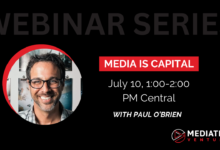
This is one of those times when one wishes they had a white board and a video camera on demand; I know many of you do, and it isn’t hard to get them, but I was sitting in my kitchen with this noodling away in my brain so I just had to draw it out, and then write it up, rather than getting to the video talk that this should be. Put on your best VR headset, get yourself in a metaverse, and pretend you’re watching this play out in front of you.
One of S. California’s most notable startup evangelists and advisors, Carey Ransom, whipped up a great 2×2 matrix last week, and I took a moment to share one that I frequently use to help illustrate the impact of Peter Drucker’s observations about value created by Innovation and Marketing:
Carey even beats Ted Cohen in being someone with whom I have a ridiculous number of shared connections. Clocking in at 957, we should just all 3 of us get together and start something with our thousand closest friends
Why I really like them is that it tends to help me frame things so I can see where things are, where they may be going, and how changes might drive disruption, new opportunities, etc.
– Carey Ransom, Founder at Operate; Managing Director at BankTech Ventures

Here’s what I’ve frequently drawn for founders – our x-axis plotting the degree to which you’re innovative while our y-axis plots your work, relative to competitors, to the degree of your focus and sophistication in marketing.
(yes, I realize, a little blurry on the left, don’t worry about it, we’ll take another look at this in a moment)
Coca-Cola comes to mind as a great example of our upper left plot; exemplifying how exceptional marketing establishes what you’re doing to exceptional success.
The traditional business you find near home would reflect our lower left – restaurants, the local jeweler, a bookkeeping practice, or neighborhood recording studio. Marketing drives a small business from being a local venture, such as a realtor, to instead being Keller Williams or CBRE
As we shift right, we’re recognizing the extent that a venture is innovative; that is, not using technology but truly inventing and applying new models, ingredients, methodologies, or yes, tech. This is startup territory. But a venture without marketing isn’t a venture that will last long, so low on our matrix is tech without a clear market or opportunity – patents, research, and Minimum Viable Products in search of a customer. These are not without value, rather, low in marketing on our matrix, we’re appropriately recognizing their value since they haven’t invested in understanding competitors, considering partners, getting to know potential customers, building an audience, or evaluating historic and future trends in the sector in which they operate, as much (or yet). Without marketing, you might have a product no one even wants.
Plotting ourselves relative to competitors in the upper right, if our venture is both innovative and prioritizing marketing, we have a company that will change the world – competitive, disruptive, meaningful, and most valued.
What Carey seeded in my brain though wasn’t just sharing my oft used exercise in explaining the critical importance of marketing and innovation, it was a thought further shared in his post, “I’ve even used them to uncover convergence opportunities, when you overlay the right axes for comparison.”
I started drawing

Hopefully that addition comes obvious (and now my photo is a little clearer)

Let’s not stop there though
See why I need a white board and video? Hopefully you caught my addition this time: Problem & Solution.
You might be thinking, what an odd addition to suggest, that marketing is associated with the problem while innovation aligns with solutions.
Or rather, it might make sense that innovation is a matter of finding solutions but why does it make sense to associate marketing with problems?
Marketing is the work of studying the market in four ways we should associate to problems in ventures:
- Knowing what the problems are in the market – what customers want or need.
- Knowing what problems will arise for your venture – what competitors and other threats exist.
- Knowing the problems competitors have so that you might focus your efforts on relative competitive advantages.
- Manifesting problems for your venture so that you need to invest in overcoming them. Yes, manifesting problems, actually creating problems that you need to hire, raise capital, or further innovate to overcome.
A point we make ad nauseum in our work to help founders is that too many are misled to think marketing = advertising and promotions. That couldn’t be further from the truth as marketing is the work of studying the market to know what to do. And thus, that means KNOWING the problems and even creating problems for your company.
Why would you want to create problems for your company??
Demand is a problem. Granted, it’s a good problem, but it’s still a problem. With demand you need staff, supply, fulfillment, and customer service, to keep up with demand.
A traditional business of few people serving a local community plots lower left on our matrix because it can capably serve the problems presented to it.
Marketing that traditional business is how they determine where else to grow (what customers want or need), how they know the challenges of growing there (perhaps a competitor in that market), how they uncover the weaknesses of others in those new markets, and in promoting themselves to the new market, that they now need to hire, raise capital, or invest in innovation to overcome new problems.
And that got me thinking. What is it that every company delivers and every startup seeks to uncover anew?
Draw a circle on our matrix. And with the Problem / Solution principles on Lean Startup in mind from our previous addition, turn your mind to Product Market Fit.

Your product, our circle, weaves throughout the matrix because it is interdependent on marketing and innovation.
Is your product simple and straightforward; delivering something that already exists? Or is it distinctly new and game changing; will it disrupt an existing market in its innovation?
Too many founders prioritize their focus on product above marketing and overlook how a successful product isn’t just something you want to bring to a market because some customers exist, but rather a solution to a complete understanding of the problems – both customer problems AND the problems you’ll have to overcome in developing a sustainable company for your new product. Product is dependent on marketing.
Is your market small? Perhaps there is great competition, and you can’t effectively sustain what you’re doing relative to their capabilities. Maybe you have failed to figure out what the market will bear when it comes to investing in you or your company.
Low on the market plot we find ourselves with efforts where the product, regardless of how great it *might* be, will not be as greatly valued because you’re neglecting what it takes to be substantial, to compete, and to deliver a product in great demand.
This is why my labeling has Product above and outside the circle; your success is not a matter of putting your product in a market but rather understanding the market so well that you know where your product fits within this matrix, and how valuable the work you’re doing will be because of that.
And yes, now the picture is clear.







Reminds me of Steve Jobs saying that people don’t know what they want until we show it to them. It sounds like hubris (and let’s admit it, it kinda was), but it’s also a fundamental understanding of the market and bringing a great product out that fit the market he was targeting.
Paul O’Brien Instead of “problem” and “solution”, I tend to use “opportunity” and “capability”.
The reason is because a “solution in search of a problem” isn’t really a solution at all.
You stay with the gems! Thank you for this work!
Shine bright like a diamond!
Jason Brewer – tagged you because your similar / related post was right above this one 🙂 Figured you might be interested.
“Your customers don’t care about your product features.” Well said
I point out all the time how confirmation bias is that you talk about features because people are curious, helpful with ideas, and want to know what it does. So you talk features. That doesn’t mean anyone cares nor that you have a sustainable business because of them.
There’s a place for talking about the details or features of your product or service, once a company/customer has raised their hand and is considering your offer. I just think too many companies lead with this me-centric info and forget that their audience isn’t looking for it. We are self-focused creatures.
Jason Brewer Too many? It’s pretty close to all. “Look at me!!” No, actually, I don’t care. What I can about is what you might be able to do for me. The irony? Marketing agencies – anecdotally, – seem to be the biggest violators.
Mark Simchock in fairness, I find most “marketing agencies” are really just inexperienced people trying to earn a living by running ads for people. They’re managing campaigns, usually poorly, not Marketing. Evident in their “hire me!”, pleas.
Mark Simchock Agreed, I do not speak for all “marketing agencies” – some are guiltier than others
Paul O’Brien I think many agencies start this way. An entrepreneurial type finds a tactic or platform that they can master and starts charging someone for it. If they keep a focus on the customer, they can grow and thrive, without a “hire me, please!” approach
The picture is clear. So good. This does need to be a video btw. Too good not to be!
Reminds me of Steve Jobs saying that people don’t know what they want until we show it to them. It sounds like hubris (and let’s admit it, it kinda was), but it’s also a fundamental understanding of the market and bringing a great product out that fit the market he was targeting (whether they understood what they wanted yet or not).
Good stuff! Another example of online, asynchronous collaboration and learning. Sharing is caring.
Great lesson Master Paul as always